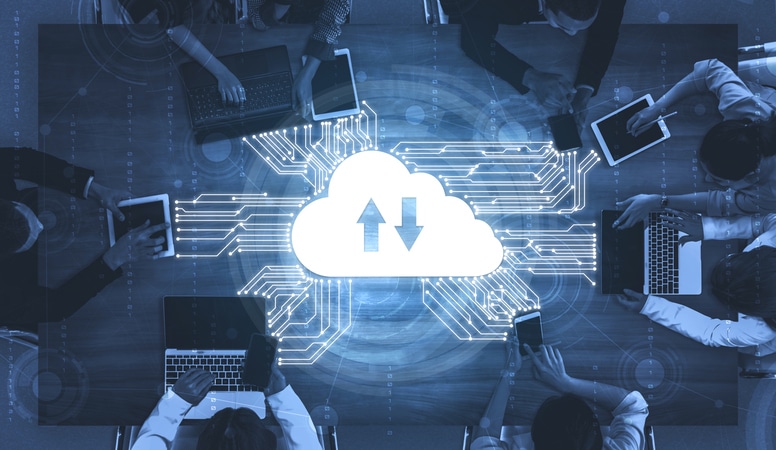Top 6 Cloud Security Trends to Be On the Lookout for in 2022
As much as cloud adoption offers flexibility and enhances productivity, it also exposes organizations to data breaches and cyber threats. According to a recent IDC survey, approximately 79% of companies have experienced at least one cloud data breach. Another study by Ponemon Institute and IBM discovered that organizations in the hybrid space incur an average cost of $3.61 million due to data breaches.
As the threat landscape continues to evolve, businesses of all sizes – large and small – must continue to evolve their security posture and practices to defend themselves from a myriad of threats that exist today, such as ransomware. In this post, we’ll outline the top cloud security trends that businesses should adopt to protect themselves from the ever-increasing cybersecurity threats.

1. End-User Cybersecurity Education
One of the most important aspects of cybersecurity is education. The end-user is the weakest link to a potential cyberattack. In fact, studies have found that over 90% of threats start with the end-user—this makes end-user training a business’s best practice.
Ongoing cybersecurity training and testing is a must. This training is readily available from IT service providers to help businesses of all sizes gain access to ongoing high-quality security training for their staff. By training their staff on cybersecurity best practices, businesses will create a human firewall, thereby strengthening their security systems.
2. Multi-Factor Authentication
Multifactor authentication is another key defence used to protect corporate systems from hackers. With the widespread adoption of multiple cloud environments, several corporate assets now exist outside the traditional security perimeter. With business boundaries becoming more blurry, trust has become a vulnerability.
Strong and effective multifactor authentication enables a granular, responsive security approach that cannot be easily breached. Multifactor authentication and zero-trust security aren’t a set of technologies, but rather a security culture that businesses need to adopt to protect themselves against current cybersecurity threats.
3. Increased Usage of DNS Filtering
With the emergence of COVID-19, the work from home revolution has created a huge security risk for corporations. DNS filtering is a key system used to protect end-users that are not behind the corporate firewall from ending up on the wrong website where they can be easily compromised.
So, how does DNS filtering work? All DNS queries go to a DNS resolver. These resolvers can act as filters by refusing to resolve queries for specific domains that are tracked in a blocklist. They, therefore, block users from reaching those domains.
Suppose an employee of a company receives a phishing email and is duped into clicking a link that leads to a malicious website, DNS filtering sends the query to the company’s DNS resolving service before the employee’s computer loads the website. In case the malicious site is on the company’s blocklist, the DNS resolver will block the request, preventing the malicious website from loading, thereby thwarting the phishing attack.
4. Managed Threat Response
Given the current prevalence of cybersecurity attacks, it’s no longer enough to deploy antivirus and anti-malware systems. Today, organizational networks must be managed round the clock by a security operations centre that is skilled and trained in threat hunting and remediation of threats in corporate environments. This is also possible for today’s small organizations that can’t afford their own round-the-clock security team to outsource that task to a managed services provider.
That said, when choosing a managed threat response solution, it’s important to select a provider that not only notifies you of an attack but also manages the threat after detecting it.
5. Dark Web Monitoring
The privacy provided by the dark web is appealing to people who want to purchase credit card numbers, stolen digital credentials, and other personal and business information, as well as hacking-as-a-service, ransomware kits, and illicit goods such as fake IDs, counterfeit currency, and drugs.
Dark web monitoring refers to the process of searching for and tracking your organization’s information on the dark web. Tools used to monitor the dark web are similar to a search engine like Google. These tools enable users to find stolen or leaked information such as breached credentials, compromised passwords, intellectual property, and other sensitive data being shared and sold among malicious actors on the dark web.
Businesses that monitor the dark web can find out whether they have been breached or find any indicators that they are likely to be breached. They can also learn who is attacking them and what methods they are using. With this information in hand, such businesses can develop measures to combat the efforts of the threat actors.
6. Automated End User Cybersecurity Awareness Training
The overhead costs associated with managing a security awareness training program can be off-putting for a busy IT department. The costs associated with the planning, development, and management of a security awareness training program can mean that an organization simply decides not to perform the training.
Being able to automate the cybersecurity awareness program and have programmable help in managing and defining tasks, offers an effective and cost-efficient way of getting the security training program up and running and keeping it going.
Automation of the security training program improves it by covering areas such as security landscape intelligence, security awareness campaign planning, automated feedback and metrics, integrated automated phishing simulations, among other areas.
Bottom Line
In the current day and age, most applications use large combinations of different open source components. If one of those components gets compromised or vulnerability is found, it will affect the software package or the whole product running in the cloud environment. Keeping open source software up to date is a mundane task and requires regular patching.
Developers do not prioritize patching until a critical vulnerability occurs. Sometimes they cannot update because it’ll affect other components and integrations, so upgrading becomes a massive project. In three years to come, we will see a lot more companies start using secure networks, and the management of third-party software will also become a critical priority for most CISOs.
The cloud security market has finally begun implementing single sign-on and multifactor authentication. This has been a great necessity to keep logins secure.
Pure IT Is Your Go-to Calvary IT Service Provider
Are you looking to beef up the security of your Calgary business? Pure IT can help. We offer the best Microsoft solutions, Microsoft support, and Managed IT services in Calgary and across Western Canada. Contact us today to learn more about our services.
Thanks to my friends at CEU Technologies in Chicago for their support with this article. Discover more at ceutechnologies.com





